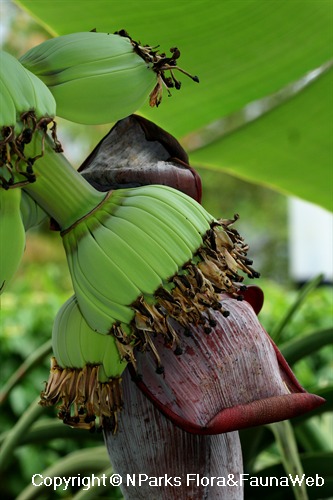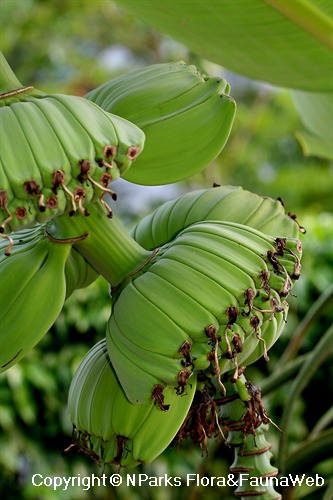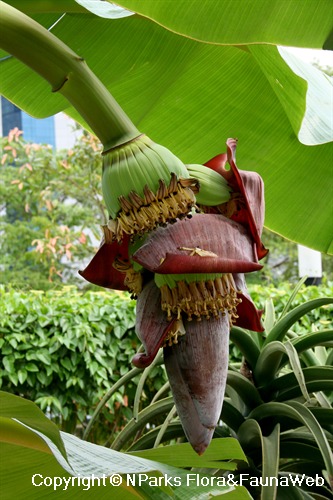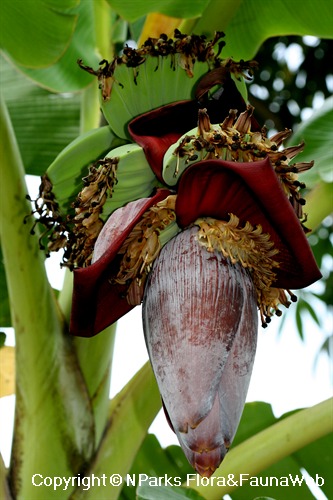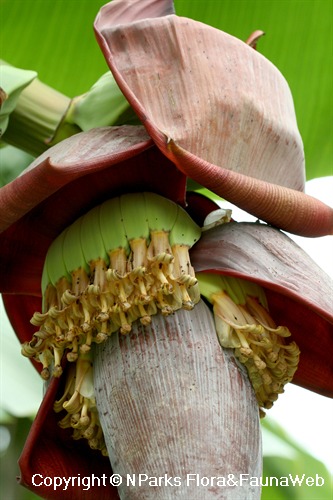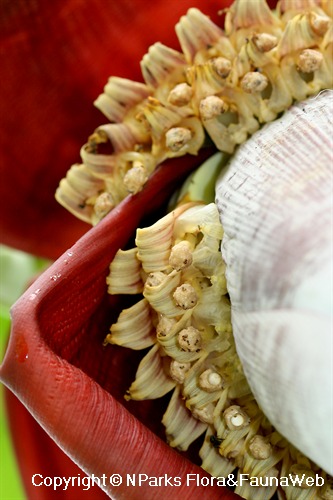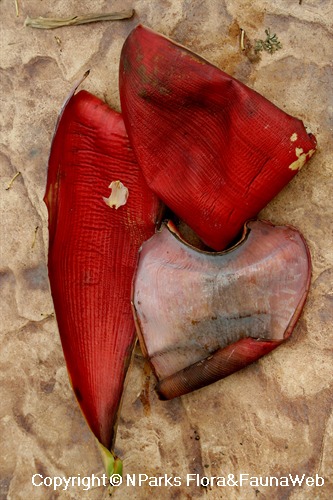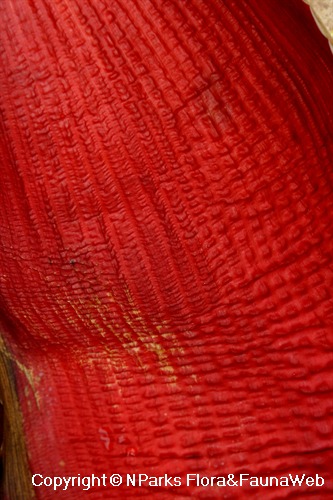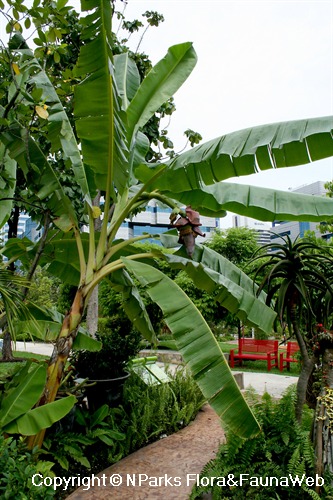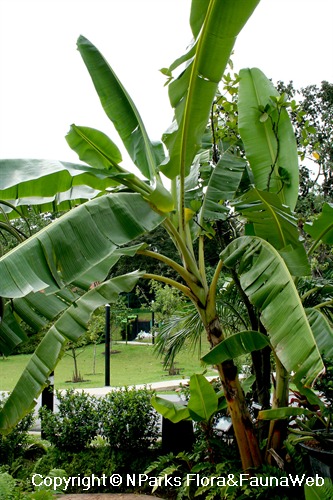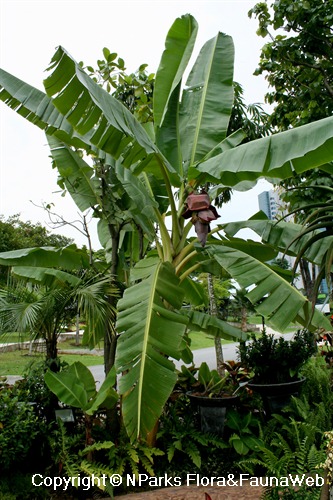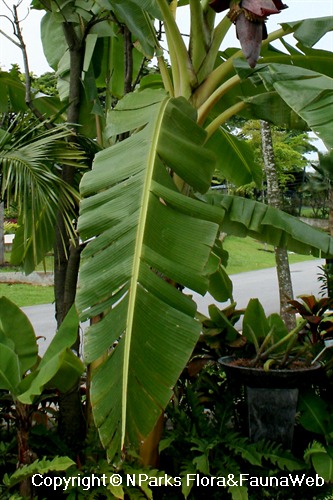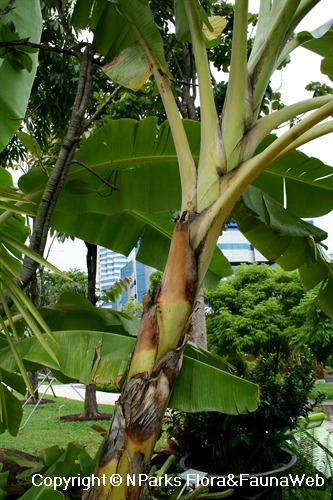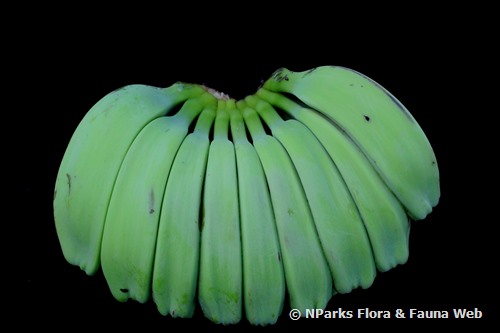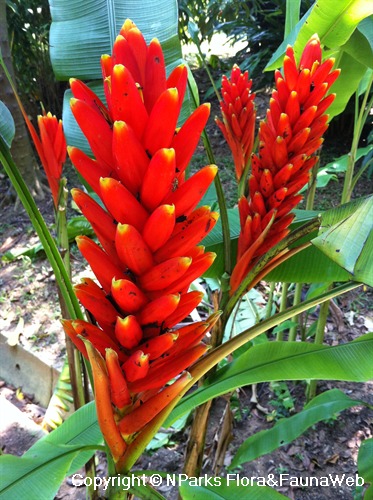
Back
Musa × paradisiaca 'Praying Hands'
| Family Name: | Musaceae |
| Synonyms: | Musa 'Praying Hands' |
| Common Name: | Praying Hands Banana, Ripping (Philippines) |
Name
Classifications and Characteristics
| Plant Division | Angiosperms (Flowering Seed Plants) (Monocotyledon) |
|---|---|
| Plant Growth Form | Herbaceous Plant |
| Lifespan (in Singapore) | Perennial |
| Mode of Nutrition | Autotrophic |
| Plant Shape | Shrubby |
| Maximum Height | 3.5 m to 5 m |
Biogeography
| Native Distribution | Indonesia |
|---|---|
| Preferred Climate Zone | Tropical |
Description and Ethnobotany
| Others - Plant Morphology | Herbaceous shrub, up to 5m height when planted in ground, smaller if grown in pots. Fronds glossy green, broad and large, 1m or more in length. Rigid pseudostem (trunk) initially arising as sucker from underground rhizomes, made up of overlapping fleshy frond-sheaths. Pseudostems and underside of leaves have whitish powdery coating.Flowers yellow, inconspicuous, held in long racemes (fruiting stem), enclosed by scarlet-red leathery bracts. Plant is monoecious, with separate male and female flowers in inflorescence on the same plant. Flower pollinated by ants, bees and birds. Female flowers can also set sterile fruits without pollination by means of parthenocarpy.Fruits ("fingers") are pulpy berries with leathery outer peel, formed in layers called combs or "hands" consisting of 10 - 20 bananas each, with several "hands" per fruiting stalk. Each "hand" consists of many "fingers" packed closely into a fused mass, which resembles a baseball mitt or a cupped hand. Two adjacent "hands" lying next to each other form what appears to be a clasped pair of hands. Fruits ripen (without splitting) from green to yellow in 2 - 3 months, with edible vanilla-flavoured pulp.Dwarf cultivar from Saba sub-group of typically massive banana species. Plant is ABB triploid, formed from hybridization of pulpy-fruited Musa acuminata (diploid AA) and Musa balbisiana (tetraploid BBBB), producing short, plump and sweet "Lady Finger" type fruits, suitable as dessert bananas -- as opposed to Cavendish type of bananas found at supermarkets.Popular collectors' item amongst banana ethusiasts. Ideal for economic gardens, or as focal plant for its unqiue-looking fruits, and to impart tropical feel to the landscape. Vigorous and fast-growing. Prefers moist soils and lots of watering, but does not tolerate being soaked in standing water. Fairly wind-resistant, but avoid locating plant in very windy areas to prevent leaves from being shredded into thin strips. Heavy feeder -- fertilize once monthly if soil is fertile, or once weekly if soil is poor. Prune off dying old fronds from pseudostem for a neater look. Prop up fruiting stem if this is leaning excessively due to the weight of the inflorescence and maturing fruits. Post-fruiting pseudostems may start to decline, so these can be removed to make space for emerging suckers, Propagate by division of suckers and seeds (rarely produced and may not be viable).Genus epithet 'Musa' named after Antonius Musa (63 - 14 BC), physician to first Roman emperor, Octavius Angustus. Also the Arabic name for the fruit, perhaps after Prophet Musa (Moses). Musa x paradisiaca form named by Linnaeus in relation to the Qu'ran's reference to banana as the "Tree of Paradise". |
|---|---|
| Ethnobotanical Uses | Edible Plant Parts : Edible Fruits Food (Fruit or Vegetable) Others: Ripe fruits can be separated from one another and eaten individually. Each "hand" of fruits can also be sliced across, and the sweet pulp scooped out with a spoon. |
Landscaping Features
| Desirable Plant Features | Ornamental Flowers, Ornamental Fruits |
|---|---|
| Landscape Uses | General, Focal Plant, Container Planting |
| Thematic Landscaping | Economic Garden, Naturalistic Garden |
Fauna, Pollination and Dispersal
| Fauna Pollination Dispersal Associated Fauna | Bird-Attracting |
|---|---|
| Pollination Method(s) | Biotic (Fauna) (Cultivars can also set sterile seedless fruit by parthenocarpy., Insects (Bee), Insects (Ant, Beetle, Fly, Thrip, Wasp), Vertebrates (Bird)) |
Plant Care and Propagation
| Light Preference | Full Sun, Semi-Shade |
|---|---|
| Water Preference | Lots of Water |
| Plant Growth Rate | Fast |
| Rootzone Tolerance | Easy to Grow, Fertile Loamy Soils, Well-Drained Soils |
| Pruning | Old drooping fronds can be pruned off to provide clearance below plant. |
| Fertilizing | Musa species are heavy feeders. Fertilize once monthly if soil is good, once weekly if soil is poor. |
| Diseases | Panama disease, Black Sigatoka (leaf spot disease) |
| Propagation Method | Seed, Sucker, Division |
| Propagule Establishment Remarks | Soak seeds in warm for a day & night, before sowing in sandy-peat mix. Germination may take up to 6 months. |
| Maintenance Requirements Remarks | Prop up plant, if fruitng inflorescence is too heavy and causes plant to lean. |
Foliar
| Foliage Retention | Evergreen |
|---|---|
| Mature Foliage Colour(s) | Green |
| Mature Foliage Texture(s) | Smooth |
| Foliar Type | Simple / Unifoliate |
| Foliar Arrangement Along Stem | Whorled |
| Foliar Shape(s) | Non-Palm Foliage (Oblong) |
| Foliar Venation | Parallel |
| Foliar Margin | Entire |
| Foliar Apex - Tip | Acuminate |
| Foliar Base | Rounded / Obtuse |
| Typical Foliar Area | Macrophyll ( 182.25cm2 - 1640.25 cm2 ) |
| Leaf Area Index (LAI) for Green Plot Ratio | 3.5 (Shrub & Groundcover - Monocot) |
Non - Foliar and Storage
| Trunk Type (Non Palm) | Non Woody |
|---|---|
| Root Type | Underground (Fibrous Root) |
| Specialised Storage Organ(s) | Underground (Rhizome) |
Floral (Angiosperm)
| Flower & Plant Sexuality | Unisexual Flowers , Monoecious |
| Flower Colour(s) | Yellow / Golden |
|---|
Fruit, Seed and Spore
| Mature Fruit Colour(s) | Yellow / Golden |
|---|---|
| Fruit Classification | Simple Fruit |
| Fruit Type | Fleshy Fruit , Berry |
Image Repository
Others
| Master ID | 29131 |
|---|---|
| Species ID | 3440 |
| Flora Disclaimer | The information in this website has been compiled from reliable sources, such as reference works on medicinal plants. It is not a substitute for medical advice or treatment and NParks does not purport to provide any medical advice. Readers should always consult his/her physician before using or consuming a plant for medicinal purposes. |

